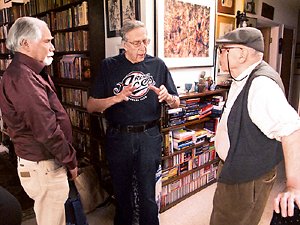Pulp Fiction: A Roundtable Discussion
In July 2010, authors Robert Silverberg, Richard A. Lupoff, and Frank M. Robinson visited the Locus offices for a roundtable discussion on the history and ongoing influence of the pulp science fiction magazines.

Photo by Amelia Beamer
Their pulp pedigrees are impressive: Silverberg wrote extensively for a number of pulps in the 1950s; Lupoff was a contemporary reader of pulp magazines, and has an encyclopedic knowledge of the field; and Robinson worked as an office boy at the Ziff-Davis publishing company in his teens, and later became one of the world’s leading experts on pulp magazines, writing extensively on the subject. He’s also the co-author of Pulp Culture: The Art of Fiction Magazines (1988) as well as author of Science Fiction of the 20th Century (1999). Liza Groen Trombi moderated the discussion.
Excerpts from the discussion:
Liza Groen Trombi: ‘‘How did the pulps get us to where we are today?’’
Frank M. Robinson: ‘‘At the end of the pulp era, a lot of the writers in the Western and detective fields shifted over to TV.’’
Robert Silverberg: ‘‘Many of the pulp writers were accustomed to writing steadily – you bang it out all day long, prolifically, to a deadline. You just had to retool that to do scripts. Then, when paperbacks happened, some of the writers moved over. The one that comes to mind is John D. MacDonald, a very good pulp writer in the ’40s who moved right on to paperbacks with the Travis McGee detective stories.’’
FMR: ‘‘And ended up on the bestseller lists.’’
RS: ‘‘Had he been doing those stories in 1937 or 1942, it would have been a magazine coming out every month, and he would have done the lead in each of those, just as Walter Gibson wrote ‘The Shadow’ every month and Lester Dent wrote ‘Doc Savage’ every month. But since MacDonald reached his prime during the paperback era, he moved along and wrote what were essentially high-class pulp mystery novels.’’
Richard A. Lupoff: ‘‘In some magazines there would be a variety of stories, as to this day in Fantasy & Science Fiction you find 10 to 15 short stories. In others, you would find a short novel and a couple of short stories, and an editorial and a letter column and all sorts of other odd little features that made up the magazine. A book is typically just a book – the latest Travis McGee novel is just The Big Purple Hotdog, or whatever it was called.’’
RS: ‘‘Another aspect of pulp metamorphosis is Captain Future. That was published from about 1940 to 1943, a kind of prototype of Star Trek. Lead novel, nearly all of them written by Edmond Hamilton (a great pulp writer) involving a small cast of characters – the hero, a robot, an android, a scientific genius – having adventures on a different planet each issue. It came out either four or six times a year. And Captain Future, as pulpy a science fiction magazine as it comes, would have evolved right into something like Star Trek, with a continuing band of characters.’’
FMR: ‘‘Captain Future is important because it was the only science fiction ‘hero’ pulp. The hero pulps were those like The Shadow, Doc Savage, The Phantom Detective, The Spider, and half a dozen others where the lead novel always featured the exploits of one man – Doc Savage, for example – and his sidekicks. They were immensely popular but the science fiction field produced only one: Captain Future.’’
RS: ‘‘Most of what we now call the tropes of science fiction, although they were all invented by H.G. Wells a hundred years ago, were developed and made into a ritual in the pulps: a common coinage. I mentioned Astounding as the first pulp science fiction magazine. Then it trimmed its edges to show that it was classy, and then the new editor John W. Campbell came in and said, ‘I don’t want to use the old pulp formulas. I want stories to be more modern, but I want them to be about the future.’ In fact, they were the old pulp formulas, just tidied up and dusted off. And we’ve continued to move on along that path – sometimes untidying. A lot of what’s being published in science fiction now, by mass-market paperback houses, harkens back thematically to Captain Future and to Planet Stories, and the rip-roaring adventure stories of the past. Star Wars and Star Trek.’’
RAL: ‘‘With pulp magazines, we’re certainly not talking about unique content, because there was science fiction beforehand: story papers, dime novels, the early turn-of-the-century paperback books. Those morphed into the pulps, and the pulps morphed into the mass-market paperback book which still exists today. And then we see more changes in media, where the same imagery, the same kind of storytelling, goes up on screen whether you’re talking about movie theater or a television show. What will come next I don’t know, because there’s a whole electronic revolution going on right now. I imagine that ten years from today, this conversation will be like listening to the Sumerians talk!’’
RS: ‘‘The pulp concept is not just a format. Certainly it’s those magazines lying on the table before us with the gaudy covers, the rough edges, the 7 x 10 paper, but it’s also a sensibility. It’s a way of telling stories in a simple, direct, fast-paced mode. And that, which was first established in Argosy and Adventure, carried on into many specialized pulp magazines in the ’30s, ’40s, and even the early ’50s. And then Avatar, Star Trek, Star Wars: these are all pulp stories in a different medium.’’
FMR: ‘‘Particularly Avatar. That could have appeared in Planet Stories – and probably should have.’’





Pingback:Tweets that mention Locus Online Perspectives » Pulp Fiction: A Roundtable Discussion -- Topsy.com
Pingback:fritz freiheit.com blog » Link dump